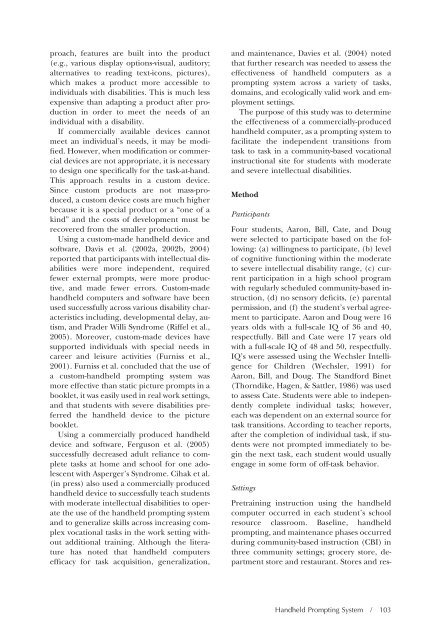Download the Journal (PDF) - Division on Autism and ...
Download the Journal (PDF) - Division on Autism and ...
Download the Journal (PDF) - Division on Autism and ...
Create successful ePaper yourself
Turn your PDF publications into a flip-book with our unique Google optimized e-Paper software.
proach, features are built into <str<strong>on</strong>g>the</str<strong>on</strong>g> product<br />
(e.g., various display opti<strong>on</strong>s-visual, auditory;<br />
alternatives to reading text-ic<strong>on</strong>s, pictures),<br />
which makes a product more accessible to<br />
individuals with disabilities. This is much less<br />
expensive than adapting a product after producti<strong>on</strong><br />
in order to meet <str<strong>on</strong>g>the</str<strong>on</strong>g> needs of an<br />
individual with a disability.<br />
If commercially available devices cannot<br />
meet an individual’s needs, it may be modified.<br />
However, when modificati<strong>on</strong> or commercial<br />
devices are not appropriate, it is necessary<br />
to design <strong>on</strong>e specifically for <str<strong>on</strong>g>the</str<strong>on</strong>g> task-at-h<strong>and</strong>.<br />
This approach results in a custom device.<br />
Since custom products are not mass-produced,<br />
a custom device costs are much higher<br />
because it is a special product or a “<strong>on</strong>e of a<br />
kind” <strong>and</strong> <str<strong>on</strong>g>the</str<strong>on</strong>g> costs of development must be<br />
recovered from <str<strong>on</strong>g>the</str<strong>on</strong>g> smaller producti<strong>on</strong>.<br />
Using a custom-made h<strong>and</strong>held device <strong>and</strong><br />
software, Davis et al. (2002a, 2002b, 2004)<br />
reported that participants with intellectual disabilities<br />
were more independent, required<br />
fewer external prompts, were more productive,<br />
<strong>and</strong> made fewer errors. Custom-made<br />
h<strong>and</strong>held computers <strong>and</strong> software have been<br />
used successfully across various disability characteristics<br />
including, developmental delay, autism,<br />
<strong>and</strong> Prader Willi Syndrome (Riffel et al.,<br />
2005). Moreover, custom-made devices have<br />
supported individuals with special needs in<br />
career <strong>and</strong> leisure activities (Furniss et al.,<br />
2001). Furniss et al. c<strong>on</strong>cluded that <str<strong>on</strong>g>the</str<strong>on</strong>g> use of<br />
a custom-h<strong>and</strong>held prompting system was<br />
more effective than static picture prompts in a<br />
booklet, it was easily used in real work settings,<br />
<strong>and</strong> that students with severe disabilities preferred<br />
<str<strong>on</strong>g>the</str<strong>on</strong>g> h<strong>and</strong>held device to <str<strong>on</strong>g>the</str<strong>on</strong>g> picture<br />
booklet.<br />
Using a commercially produced h<strong>and</strong>held<br />
device <strong>and</strong> software, Fergus<strong>on</strong> et al. (2005)<br />
successfully decreased adult reliance to complete<br />
tasks at home <strong>and</strong> school for <strong>on</strong>e adolescent<br />
with Asperger’s Syndrome. Cihak et al.<br />
(in press) also used a commercially produced<br />
h<strong>and</strong>held device to successfully teach students<br />
with moderate intellectual disabilities to operate<br />
<str<strong>on</strong>g>the</str<strong>on</strong>g> use of <str<strong>on</strong>g>the</str<strong>on</strong>g> h<strong>and</strong>held prompting system<br />
<strong>and</strong> to generalize skills across increasing complex<br />
vocati<strong>on</strong>al tasks in <str<strong>on</strong>g>the</str<strong>on</strong>g> work setting without<br />
additi<strong>on</strong>al training. Although <str<strong>on</strong>g>the</str<strong>on</strong>g> literature<br />
has noted that h<strong>and</strong>held computers<br />
efficacy for task acquisiti<strong>on</strong>, generalizati<strong>on</strong>,<br />
<strong>and</strong> maintenance, Davies et al. (2004) noted<br />
that fur<str<strong>on</strong>g>the</str<strong>on</strong>g>r research was needed to assess <str<strong>on</strong>g>the</str<strong>on</strong>g><br />
effectiveness of h<strong>and</strong>held computers as a<br />
prompting system across a variety of tasks,<br />
domains, <strong>and</strong> ecologically valid work <strong>and</strong> employment<br />
settings.<br />
The purpose of this study was to determine<br />
<str<strong>on</strong>g>the</str<strong>on</strong>g> effectiveness of a commercially-produced<br />
h<strong>and</strong>held computer, as a prompting system to<br />
facilitate <str<strong>on</strong>g>the</str<strong>on</strong>g> independent transiti<strong>on</strong>s from<br />
task to task in a community-based vocati<strong>on</strong>al<br />
instructi<strong>on</strong>al site for students with moderate<br />
<strong>and</strong> severe intellectual disabilities.<br />
Method<br />
Participants<br />
Four students, Aar<strong>on</strong>, Bill, Cate, <strong>and</strong> Doug<br />
were selected to participate based <strong>on</strong> <str<strong>on</strong>g>the</str<strong>on</strong>g> following:<br />
(a) willingness to participate, (b) level<br />
of cognitive functi<strong>on</strong>ing within <str<strong>on</strong>g>the</str<strong>on</strong>g> moderate<br />
to severe intellectual disability range, (c) current<br />
participati<strong>on</strong> in a high school program<br />
with regularly scheduled community-based instructi<strong>on</strong>,<br />
(d) no sensory deficits, (e) parental<br />
permissi<strong>on</strong>, <strong>and</strong> (f) <str<strong>on</strong>g>the</str<strong>on</strong>g> student’s verbal agreement<br />
to participate. Aar<strong>on</strong> <strong>and</strong> Doug were 16<br />
years olds with a full-scale IQ of 36 <strong>and</strong> 40,<br />
respectfully. Bill <strong>and</strong> Cate were 17 years old<br />
with a full-scale IQ of 48 <strong>and</strong> 50, respectfully.<br />
IQ’s were assessed using <str<strong>on</strong>g>the</str<strong>on</strong>g> Wechsler Intelligence<br />
for Children (Wechsler, 1991) for<br />
Aar<strong>on</strong>, Bill, <strong>and</strong> Doug. The St<strong>and</strong>ford Binet<br />
(Thorndike, Hagen, & Sattler, 1986) was used<br />
to assess Cate. Students were able to independently<br />
complete individual tasks; however,<br />
each was dependent <strong>on</strong> an external source for<br />
task transiti<strong>on</strong>s. According to teacher reports,<br />
after <str<strong>on</strong>g>the</str<strong>on</strong>g> completi<strong>on</strong> of individual task, if students<br />
were not prompted immediately to begin<br />
<str<strong>on</strong>g>the</str<strong>on</strong>g> next task, each student would usually<br />
engage in some form of off-task behavior.<br />
Settings<br />
Pretraining instructi<strong>on</strong> using <str<strong>on</strong>g>the</str<strong>on</strong>g> h<strong>and</strong>held<br />
computer occurred in each student’s school<br />
resource classroom. Baseline, h<strong>and</strong>held<br />
prompting, <strong>and</strong> maintenance phases occurred<br />
during community-based instructi<strong>on</strong> (CBI) in<br />
three community settings; grocery store, department<br />
store <strong>and</strong> restaurant. Stores <strong>and</strong> res-<br />
H<strong>and</strong>held Prompting System / 103
















